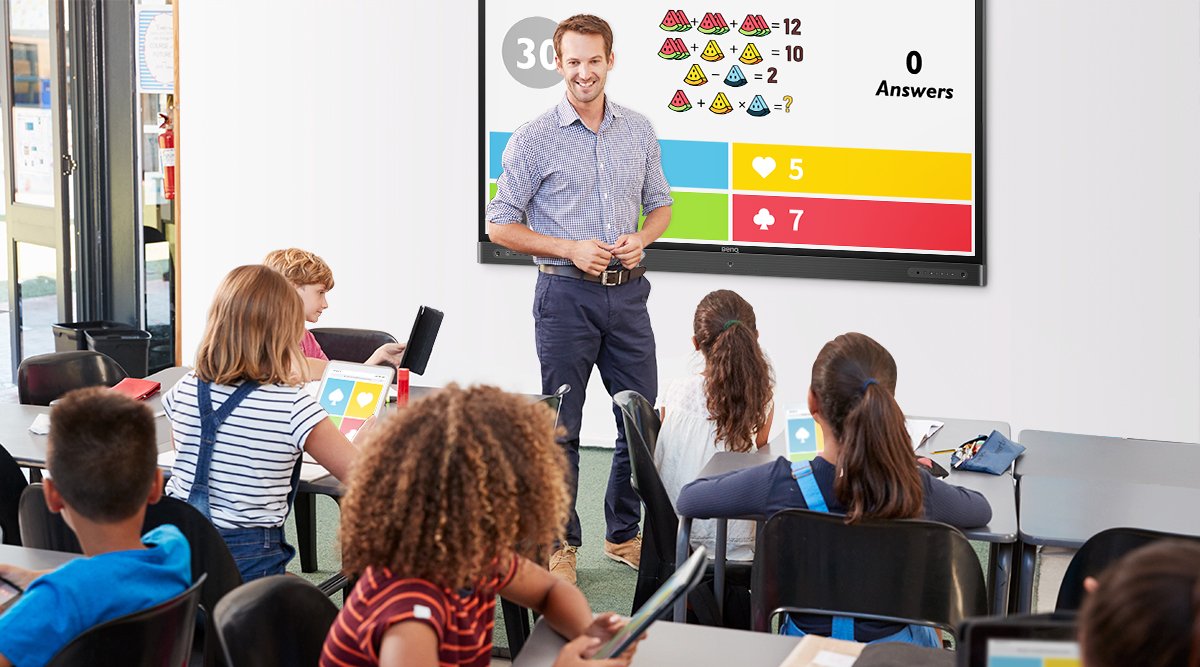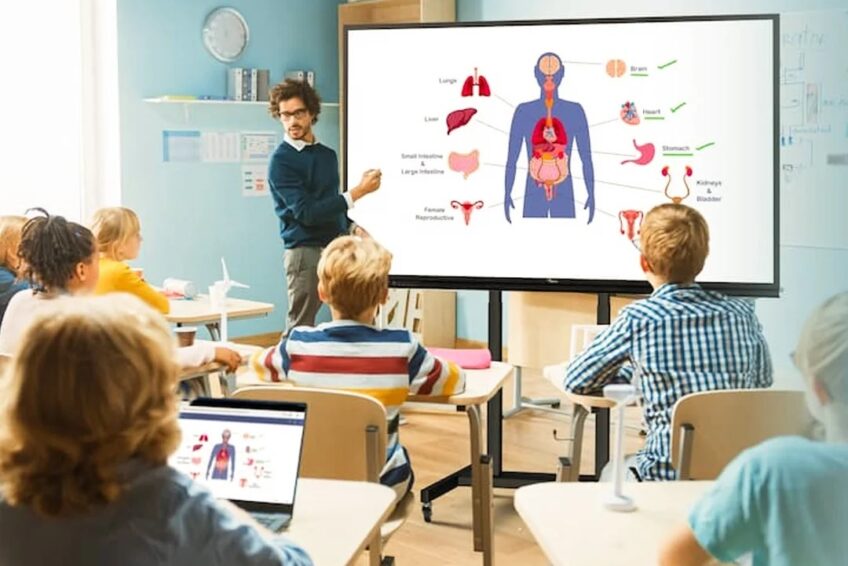PRODUCTS WE OFFERS:
- 1.Cameras
- 2.IFP panels
- 3.Screens
- 4.Lab management
- 5.Virtual learning
Cameras

A camera is an instrument used to:
-
Capture and store images and videos, either digitally via an electronic image sensor or chemically via photographic film.
-
Record an image of an object on a light-sensitive surface using a lens and sensor (or film).
- Essentially, a camera is a light-tight box with an aperture to admit light focused onto a sensitized film or plate.The term camera comes from the word “Camera Obscura” (Latin for "dark chamber).
The modern camera evolved from the camera Obscura & functioning of the camera is very similar to
the functioning of the human eye.
A few types of Camera:
- 1.TLR- Twin-Lens Reflex camera
- 2.SLR - single-lens reflex camera
- 3.Range Finder Camera
- 4.Instant Camera
- 5.Video Cameras
- 6.Camcorders
- 7.Convertible camera
The Parts of the Camera:
- The camera is comprised of four major parts:
1. Camera Head
2. Viewfinder
3. Camera Lens
4. Recorder
1.Camera head:
- The Camera Head is the portion of the video camera that contains all the electronics needed to
convert the reflection of light from the subject into an electronic signal.
2.Viewfinder:
- The viewfinder is a small video monitor attached to the camera that allows the camera operator
to view the images in the shot.
3.Camera Lens:
- The lens is an assembly of several glass discs placed in a tube on the front of a camera. Its
primary purpose is to concentrate, or focus, the incoming light rays on the surface of the imaging
device, or the target. A picture is considered to be “in focus” when the adjoining lines of contrast
are as sharp as possible.
IFP PANELS
Interactive flat panels are fast becoming the preferred display solution for businesses and educational institutions alike. Also known as interactive displays or interactive panels, these panels offer a wide range of benefits over traditional display solutions, including enhanced collaboration, engagement, and efficiency. In this blog, we'll take a closer look at what interactive flat panels are, their benefits, and why they are gaining popularity in the education and business sectors.An interactive flat panel (IFP) is a display solution that incorporates a touch-sensitive screen to enable interactivity with on-screen content. These panels can be wall-mounted or placed on a stand, and they come in a variety of sizes ranging from 55 inches to 98 inches. Some interactive flat panels also offer built-in audio and video capabilities, making them an all-in-one solution for video conferencing, presentations, and other collaborative tasks. Cornea interactive flat panel comes with all latest technology.
Interactive flat panels are typically used in classrooms and meeting rooms, but they are also used in other settings such as trade shows, museums, and exhibitions. They are designed to offer a collaborative and interactive environment that enhances communication, productivity, and learning.
Interacive flat pannel for education
Interactive flat panels are revolutionizing the classroom environment by making learning more interactive, engaging, and fun. They allow teachers to create interactive lessons, quizzes, and activities that capture students' attention and encourage participation. With an interactive flat panel, teachers can present material in a variety of formats, including images, videos, and text, and they can annotate content in real-time to highlight key points.
Interactive flat panels also offer a range of tools and features that support different learning styles, including touch-based interaction, multi-user support, and the ability to switch between different input devices. For example, teachers can use a stylus, a finger, or a digital pen to write on the screen, and students can use their own devices to collaborate and share content.
Uses of Interactive Flat Panel in Education
1.Smart Classrooms
One of the most common uses of Interactive Flat Panel is in smart classrooms. Teachers can write, draw, annotate, and play multimedia content all from a single screen. Integration with platforms like Google Classroom, MS Teams, and Zoom makes learning seamless and hybrid-friendly.
2.Remote and Hybrid Learning 
With built-in cameras, microphones, and video conferencing software, IFPs facilitate live classes, recording of lectures, and interactive
Q&A sessions—essential in today’s post-pandemic learning model.
3.Collaborative Student Projects
Students can work in groups, use the IFP for brainstorming, showcasing presentations, or conducting real-time research during class.
4.Assessment and Feedback
Teachers can conduct live quizzes, polls, and assessments using IFP tools, giving instant feedback and fostering participation.
uses of interactive flat pannel for business
In the modern digital world, where engagement, efficiency, and clarity are paramount, technology continues to evolve the way we communicate, teach, and collaborate. One such game-changing innovation is the Interactive Flat Panel (IFP). As classrooms and conference rooms transform into interactive hubs, the uses of Interactive Flat Panel are multiplying across industries.Companies like Digital Live Services are at the forefront of this evolution, offering advanced, tailored solutions that integrate IFPs seamlessly into your daily workflow—whether you’re in education, business, or public service.

Why the World is Turning to Interactive Flat Panels
- Enhanced visual engagement with Ultra HD displays
- Interactive collaboration through touch and stylus input
- Seamless device integration (laptops, smartphones, tablets)
- Cost-effective long-term investment (no projectors, bulbs, or chalk dust)
- Easy to use, with minimal training required.
Screens
“screens” usually refer to display devices used for teaching, learning, collaboration, and administration. These include:
Types of Screens:
-
Interactive Flat Panels (IFPs) – Touch-enabled smart screens (like large tablets)
-
Smart Boards – Whiteboards with digital and touch features
-
Monitors – Used with desktop computers in labs
-
Projectors with Screens – Older classrooms often use these to display lessons
-
Tablets/Chromebooks – Student-facing screens for 1:1 learning
-
Digital Signage – Screens used in hallways or entrances for announcements
Why Are Screens Important in Education?
- 1.Engagement
- 2.Digital Literacy
- 3.Access to Multimedia
- 4.Personalized Learning
Popular Educational Screen Brands
- 1.ViewSonic
- 2.SMART Technologies
- 3.BenQ
- 4.Samsung Education
- 5.Promethean
- 6.LG Interactive Displays
Core Benefits
- 1.High‑quality visuals & performance
- 2.Touch and gesture interactivity
- 3.Strong collaboration & inclusivity
- 4.Immediate feedback & assessment
- 5.Versatile use cases
- 6.Operational efficiency
Productivity & Classroom Management
- Preloaded education software: Many panels include built-in apps for subjects like math, science, and language arts.
-
Content sharing: Teachers can import existing whiteboard lessons, switch modes, bookmark apps, and mirror devices .
-
Classroom tools: In-built timers, noise meters, screen spotlighting, and interactive widgets help manage engagement—Samsung WAF supports up to 40 touch points .
-
Announcements/digital signage: Idle screens can display alerts, schedules, or important messages dynamically.

Lab management
Laboratory Information Management System (LIMS) is a specialized software designed to streamline and optimize various laboratory processes.It serves as a centralized platform that effectively manages and organizes data and information related to laboratory operations.

Lab management is the backbone of any successful research environment. From coordinating lab operations, managing resources, and guiding personnel, lab managers ensure that research runs smoothly, efficiently, and safely. Effective lab management doesn’t just keep the lab organized it drives innovation, ensures compliance with safety and regulatory standards, and enables the lab to reach its full potential.Dealing with increasing volumes of data, laboratories can no longer feasibly manage experiments by gluing printed results into a paper notebook. With a Laboratory Information Management System, researchers can now link experiments to specific samples or files, as well as easily share information with other lab members and organizations involved.
Dealing with increasing volumes of data, laboratories can no longer feasibly manage experiments by gluing printed results into a paper notebook. With a Laboratory Information Management System, researchers can now link experiments to specific samples or files, as well as easily share information with other lab members and organizations involved.
What is a Laboratory Information Management System (LIMS)?
There are various LIMS solutions depending on the industry: food and beverage testing, water and wastewater, agriculture and farming, etc. But in this article, we’ll be talking primarily about LIMS in healthcare.Though LIMS keeps expanding its functionality, which in turn changes how the system is defined, we can identify its basic functions focusing on the core function - effective sample management.
This process includes six phases:
1.receiving a sample and registering it along with the related customer data.
2. monitoring: scheduling and tracking the sample.
3. sample processing: managing the utilized equipment, inventory, and the corresponding analytical workload.
4. quality control:inspecting and approving the results.
5. compiling the sample data for reporting.
6. storing the sample analysis data.
Laboratory Information Management System (LIMS) features:
- 1.Sample Management
- 2.Workflow Management
- 3.Data Management
- 4.Instrument Integration
- 5.Quality Control and Compliance
- 6.Reporting
- 7.Inventory and Resource Management.
Virtual learning
Virtual learning refers to an environment where students study a digital-based curriculum taught by instructors that lecture online via video or audio. This instruction can take place either in a self-paced (asynchronous) environment or in a real-time (synchronous) environment.
Benefits of virtual learning
The virtual learning environment is a good choice for people who enjoy learning on their own, without restrictions on space and time. Some virtual learning options have classes to attend at scheduled times, while others allow you to learn at your own pace.With this self-paced option, you have a lot of autonomy with the intensity and cadence of your learning while still enjoying the benefits of guided lessons. Virtual learning can be convenient, flexible, and affordable.
3 types of virtual learning
- 1.synchronous
- 2.asynchronus
- 3.hybrid
Advantages of virtual learning in schools
Virtual learning gives students access to coursework from anywhere, at any time, making learning convenient. Asynchronous classes also give an immense amount of flexibility for lectures and studying. Even with the flexibility of the course, online courses are associated with higher retention rates and graduation rates. Studies show that students taking virtual classes benefit from increased access and cost savings compared to traditional delivery methods Completing courses virtually can also increase students' digital aptitude, preparing them for life in the workforce.
Disadvantages of virtual learning in schools
Technology offers us wonderful opportunities like the ability to learn from home, but it also may lead to momentary malfunctions, like interruptions or downtime Since virtual learning takes place on a screen, you might feel that the course isn’t as fully immersive compared to in-person instruction. You may feel a lack of collaboration or networking since you’re not sitting next to others as in a classroom setting. For some, that’s a con, but it may not be an issue for people who prefer a more individualistic learning approach.
For some students, the ability to study and learn comfortably from home could be a huge benefit. For others, learning at home can be distracting. Interruptions from family members and access to a phone and entertainment can make focusing more difficult, and some people may even feel isolated.Accountability can be lacking with virtual learning, so students will need to have a good sense of self-motivation or know where to go for help.
Importance of Virtual Learning in Modern Education
- 1. Adaptation to Technological Advancements
- 2. Flexibility for Diverse Learners
- 3. Meeting Global Education Challenges
- 4. Career Readiness and Professional Development
- 5. Enhancing Educational Outcomes
- 6. Sustainability and Environmental Impact

